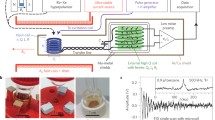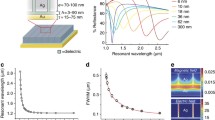Abstract
Electron spin resonance (ESR) is a powerful spectroscopic technique that has many applications in a wide variety of scientific fields, including chemistry, biology, materials science, and physics. One significant drawback of conventional ESR, however, is its relatively low sensitivity compared to other spectroscopic techniques. Arguably, the most dominant element affecting ESR sensitivity is the microwave resonator used to pick up the ESR signal of the spins. Traditionally, ESR mostly employs a limited set of resonator configurations (e.g., rectangular cavity, dielectric, or loop-gap resonator) that are suboptimal with respect to a wide range of samples. In principle, a smart resonator design can be used to optimize spin sensitivity for a given sample’s properties. In this work, we make use of an efficient Genetic Algorithm (GA) approach to numerically solve, analyze, and optimize a unique class of surface microresonators. The GA is based on a method of moments code, customized directly to render the complexity of a particular resonator’s geometries in our search. The main purposes of the algorithm are to routinely generate more sensitive microresonators, optimized for a predefined sample’s dimensions, and to study the functional relations between the devices’ resonance frequency, quality, and filling factors and their topology, in order to reach a rational optimal design. Preliminary results associated with new, unique, and sensitive surface microresonators are shown and analyzed. Such resonators are cheap and easy to produce on a mass scale with an arbitrary surface geometry.










Similar content being viewed by others
References
A. Blank, J.H. Freed, Isr. J. Chem. 46(4), 423–438 (2006)
Y. Twig, E. Suhovoy, A. Blank, Rev. Sci. Instrum. 81(10), 104703 (2010)
A. Blank, C.R. Dunnam, P.P. Borbat, J.H. Freed, J. Magn. Reson. 165(1), 116–127 (2003)
W. Wallace, R. Silsbee, Rev. Sci. Instrum. 62(7), 1754–1766 (1991)
B. Johansson, S. Haraldson, L. Pettersson, O. Beckman, Rev. Sci. Instrum. 45(11), 1445–1447 (1974)
C.P. Lin, M.K. Bowman, J.R. Norris, J. Magn. Reson. 65(2), 369–374 (1985)
N.I. Avdievich, G.J. Gerfen, J. Magn. Reson. 153(2), 178–185 (2001)
R. Narkowicz, D. Suter, R. Stonies, J. Magn. Reson. 175(2), 275–284 (2005)
O. Benningshof, H. Mohebbi, I. Taminiau, G. Miao, D. Cory, J. Magn. Reson. 230, 84–87 (2013)
A. Bienfait, J. Pla, Y. Kubo, M. Stern, X. Zhou, C. Lo, C. Weis, T. Schenkel, M. Thewalt, D. Vion, D. Esteve, B. Julsgaard, K. Moelme, J.J.L. Morton, P. Bertet, Nat. Nanotechnol. 11(3), 253–257 (2016)
H. Malissa, D. Schuster, A. Tyryshkin, A. Houck, S. Lyon, Rev. Sci. Instrum. 84(2), 025116 (2013)
A. Imamoglu, Phys. Rev. Lett. 102(8), 083602 (2009)
R.D. Britt, M.P. Klein, J. Magn. Reson. 74(3), 535–540 (1987)
W. Froncisz, J.S. Hyde, J. Magn. Reson. 47(3), 515–521 (1982)
J.S. Hyde, W. Froncisz, T. Oles, J. Magn. Reson. 82(2), 223–230 (1989)
Y. Twig, E. Dikarov, A. Blank, Mol. Phys. 111(18–19), 2674–2682 (2013)
R.F. Harrington, Proc. IEEE 55(2), 136–149 (1967)
K.-F. Man, K.S. Tang, S. Kwong, Genetic Algorithms: Concepts and Designs (Springer, London, 2012)
M. Mitchell, An Introduction to Genetic Algorithms (MIT Press, Massachusetts, 1998)
R.L. Wood, W. Froncisz, J.S. Hyde, J. Magn. Reson. 58(2), 243–253 (1984)
R.E. Collin, Foundations for Microwave Engineering (Wiley, New York, 2007)
K.S. Yee, SIAM J. Appl. Math. 18(1), 77–83 (1970)
L. Shtirberg, Y. Twig, E. Dikarov, R. Halevy, M. Levit, A. Blank, Rev. Sci. Instrum. 82(4), 043708 (2011)
A. Blank, Y. Twig, Y. Ishay, J. Magn. Reson. 280, 20–29 (2017)
Y. Artzi, Y. Twig, A. Blank, Appl. Phys. Lett. 106(8), 084104 (2015)
Acknowledgements
This work was partially supported by Grant #310/13 from the Israel Science Foundation (ISF), Grant #3-12372 from the Israeli Ministry of Science and Grant # 1352-302.5 from the German-Israeli Foundation (GIF).
Author information
Authors and Affiliations
Corresponding author
Rights and permissions
About this article
Cite this article
Ishay, Y., Blank, A. Optimization Methods for the Design of Sensitive Surface ESR Resonators. Appl Magn Reson 48, 1249–1262 (2017). https://doi.org/10.1007/s00723-017-0941-6
Received:
Revised:
Published:
Issue Date:
DOI: https://doi.org/10.1007/s00723-017-0941-6




